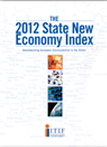
More than three years on from the end of the Great Recession, only six states have regained employment levels enjoyed prior to the recession, and 17 states are still more than 5 percent below their pre-recession employment levels. As many state economies continue to struggle through the lingering effects of the Great Recession, a question commonly asked is, “What is this seemingly invisible force that prevents the economy from returning to prerecession and especially 1990s growth rates?” In other words, why is it that, despite massive monetary and fiscal stimulus, employment seems locked in a persistent malaise? Some argue that the problem is a lack of consumer demand and that more federal government stimulus spending is the answer. Others argue that it is uncertainty over the massive national debt and that fiscal austerity is the answer.
However, one diagnosis that has gone largely unnoticed holds that this invisible force is the decline in the competitiveness of the U.S. economy in the global marketplace. As ITIF points out in Innovation Economics: The Race for Global Advantage, this decline has been a relatively untold story over the past decade, although its symptoms have clearly manifested in the dramatic fall in manufacturing employment and investment since 2000. The failure of the United States to adapt to a global economy that is evermore dependent on knowledge and innovation for growth—the so-called “New Economy”—is causing traded sector firms, and manufacturers in particular, to look to other, more competitive countries when it comes to choosing locations. And this loss of traded sector activity, including jobs and investment, holds back the entire U.S. economy and its component state economies as well.
